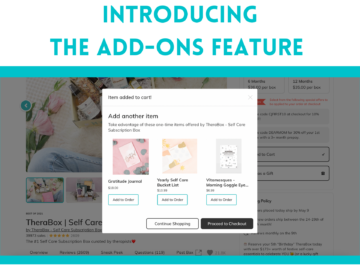The e-commerce industry for subscription boxes is exploding. Hundreds of new subscriptions have been started in the last few years, and even with the industry’s impressive growth, these new startups have just begun to scratch the surface on the numerous niches and interests these types of business can service. There are still so many good ideas out there, and considering the relative simplicity of running these businesses, there has been a huge spike in interest, especially by first-time entrepreneurs.
But these types of businesses still require effort – and lots of it. They aren’t turnkey cash machines, and they require a proper understanding of operations and positioning more than anything else.
If you’re thinking about starting a subscription business, here are a few pieces of advice before you get started:
Suggestion #1: Get Inspired
There’s an old adage I think is important for any first-time business owner: “Do what you love and you’ll never work a day in your life.”
This is a critical point to consider if you’re about to start your own business. Now’s your chance to create something for you, because you love it. To start getting inspired, I suggest reading success stories about other subscription box sellers and just how powerful this industry is. You can look at the hugely successful businesses in the space, like Loot Crate or Ipsy, read about America’s subscription box obsession as a whole, or even check out smaller subscription businesses who are taking their dreams to the next level, like Hustle and Grind and Wet Shave Club. We also post some pretty inspirational entrepreneurial stories on the Cratejoy blog.
The takeaway: If you’re thinking about starting a subscription business, make sure that it’s something you’re passionate about and willing to throw yourself into. Even if you don’t plan to turn it into a business with 500,000 subscribers, realize that this is a unique opportunity to plan and create an incredible lifestyle business that will last years.
Suggestion #2: Use Tools and Industry Knowledge
So now that you’re inspired, where do you start? Unfortunately, for many blossoming industries, there’s generally little information about what to do and how to do it well. But there is good news: Cratejoy is changing that for subscription boxes.
Subscription School: I spend a lot of my time developing guides, videos and walkthroughs for Subscription School, which is like an online academy for subscription businesses. We also interview venture capitalists and invite other experts to share their thoughts. This is a great place to get the foundational knowledge for starting your business.
Subscription Box Calculator: What to figure out your COGS, profit, LTV, and churn? Want to figure out what those metrics even are? Our Subscription Box Calculator is a revolutionary tool for starting a subscription business. Seriously, if I had access to this when starting my project, I would have saved hours in time, headaches, and frustration. Build a beautiful financial plan, then export it, in a matter of minutes.
Subscription Box Shipping Calculator: Another priceless tool from Cratejoy, free for use. Use this calculator to determine average shipping costs, get a better understanding of how shipping zones work, and even enter custom dimensions to see what your specific box cost will look like. Plug this into the above calculator for more precise planning.
Pricing Guide Calculator: Figure out how much to charge for your subscription box with this calculator. One of the biggest mistakes new business owners is not charging enough for their box, which makes it difficult grow long term.
Suggestion #3: Analyze Team Strengths
None of us are smarter than all of us.
Take a moment to read the above a few times. While this humbling sentiment may first quell your ego, it’s meant to illustrate that teams are greater than the individual. When you have a group of dedicated and talented people, you’re able to do a lot more a lot better than just working by yourself.
The first step to making the most of your team involves analyzing team strengths. One of my favorite pieces of research on this comes from Gallup, in the book Strengths Based Leadership. It breaks up strengths into four distinct categories: Executing, Influencing, Relationship Building, and Strategic Thinking. Moreover, it emphasizes that it’s very unlikely for any one individual to possess all four strengths, and that means that while individuals need not be well-rounded, teams should be.
Why is this important? In a startup, things can get stressful. You can have the types who want to execute, execute, execute. Likewise, you have the types that want to keep employees chipper and maintain a “healthy work-life balance.” Surely both types are needed – and the best teams have these people. Equally certain: these types are bound to clash. Performing analysis on your team and determining who’s who can help you put people in the right positions and more effectively mediate between the strengths. It also helps you as a business leader to realize that strengths come in different shapes and sizes. If you’re an executor, realize that some on your team may not be – and that’s okay, as long as they flex their strengths in the name of the business.
Tip: SWOT analysis is another widely used tool, which looks at Strengths, Weaknesses, Opportunities, and Threats in a team. Consider performing this same test as well when planning out your team and first hires.
Suggestion #4: See the Value in Strong Creative Resources
Let’s change gears a moment. While we’ve been focusing on preparatory tasks, the second half of these suggestions will deal with more tangible elements in launching your business. The first thing I like to stress is creative resources and design thinking.
I’ll be honest: I’ve been the “content” and “community” guy for as long as I can remember. That basically means I write the words, make sure customers are happy, and that our teams function well. This is also probably one of the furthest positions away from creative design (like photography, graphic design, or web design). Even so, I think it is beyond critical for you to immerse yourself in this thinking. While I rarely held the pen on these projects, I fully understood their value, and so should you. Strong creative resources mean higher conversion rates. Higher conversion rates mean more customers. More customers mean more revenue. And all good things follow from that.
We live in the Era of Design. The internet has democratized design and made it a more accessible commodity. As a result, it’s turned us all into design snobs; we like to think we know what looks goods and “intuitive.” Finding someone – or developing your own skills – to bring these ideas to life is critical for your business, and if you start this at day one, it grows exponentially.
The takeaway: from the minute you launch your business, be thinking about design and how that affects customer experience, regardless if you’re the designer or not.
Suggestion #5: Plan Out Your Boxes
Inching closer to your actual launch, another exercise I recommend comes with planning out your boxes. Procurement rarely is precise – you know what items you want, but usuall,y you end up working with other vendors than the ones you originally identified. Luckily, that’s not what we’re talking about.
When it comes to planning out your boxes, what I’m really referring to planning out your themes. These are the stories and topics that create cohesive experiences between products and your customers. While there are boxes that can get away with a random smattering of products, customer experience inside the box can be greatly heightened when it actually follows a clear storyline.
Think about what your subscription offers and how you can create stories around that offering. If you’re working on a gamer/geek box, maybe the themes revolve around specific video game genres. If you’re working on an organic, fair trade box, maybe themes on specific places would add to the experience. Determine what would work with your box, then try to plan out 6-12 months of boxes. Creating a roadmap can help ease procurement down the line, keep customers happy, and inspire fresh thinking when it comes to advertising and building content around your brand.
Suggestion #6: Crowdfund for Startup Costs
One of the biggest pieces of advice I give to new subscription box owners is to get a custom box made. Rather than using a plain brown parcel or USPS branding mailer, using a custom box seriously adds to the customer experience. It can be used to reinforce your value, mission, and draw the customer’s attention to key elements of your business that encourage them to stay subscribed longer.
In many ways, I see this as being just as essential as having a custom domain (www.yourwebsite.com) and using third party resources, like Zendesk for customer service or Solve360 as a CRM. Like these other resources and tools, however, a custom box costs money (about $2000). This all adds up – and for a bootstrapped startup, it can seem insurmountable.
That’s why I sometimes suggest trying to crowdfund a small piece of capital to offset your startup costs. We’ve been doing analysis on crowdfunding in the subscription box space, and I continue to be blown away with the number of businesses who have been able to successfully raise thousands to cover costs. If you have a strong network of family and friends, this is a great way to both pre-sell boxes and relieve startup stress with finances. Spend some time checking out boxes on Kickstarter and Indiegogo, model your campaign in a similar way, and see what type of funding you can attract. Running a crowdfunding effort in tandem with #7 on this list can seriously help get your business on its feet.
Suggestion #7: Plan a Prelaunch
My last suggestion deals with the actual launch of your business. Across the board, I encourage you to plan out a prelaunch.
Your prelaunch phase is when you collect emails and build a “presubscriber list,” as well as build up your social media marketing presence to create community. Like a crowdfunding campaign, one of the primarily reasons to do this is to cover costs – you’re collecting revenue from subscribers that you’ll then use to purchase products, cover shipping, and pay for supplies, like boxes, labels, and packing materials. This is also a great way to build momentum for your business, gauge consumer interest, and get a feel for what the future operation will look like.
We’ve covered prelaunching (I even did a dance about it…), and there are tons of resources and platforms that make this easy. Once you’ve got your presubscriber list built up, all you need to do is get your Cratejoy store launched and you’re ready to kick off your business.
Start Your Own Subscription Business
With these pieces of advice in hand, I hope wrestling with your own subscription business becomes a bit easier. As we mentioned, these are incredible businesses to start, regardless if your vision is to build the next Birchbox or you just want a lifestyle business to support yourself. But you’ve got to plan and prepare accordingly! Find your inspiration, leverage the tools at hand, know your strengths, and understand the value in developing great design. Likewise, make a point to exercise foresight when it comes to planning out your boxes, and even consider crowdfunding, perhaps in tandem with a prelaunch, to ensure that you never come out of pocket.
For more information, check out our posts at SubscriptionSchool. Best of luck!



